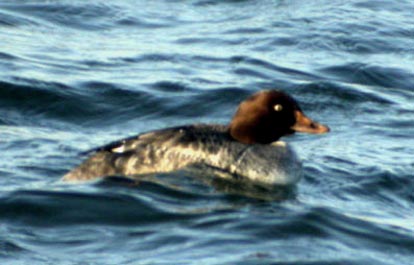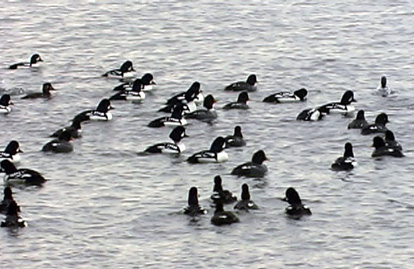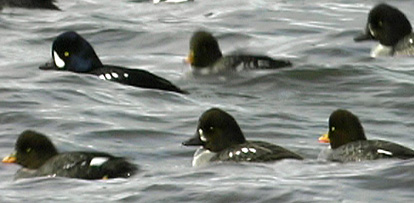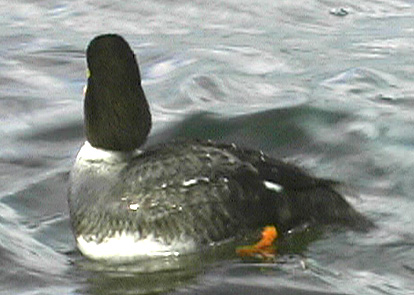and Common Goldeneye Bucephala clangula - more than just bill colour
Update added January 13th 2004
Reference to Lee, Koo and Park (2000), the field guide most likely to be used by birders either living in or visiting Korea, makes separation of female-type Common Bucephala clangula and extralimital Barrow’s Goldeneye B. islandica seem straightforward: female Barrow’s shows a largely yellowish bill (as likely deriving from western populations of the species), and more enigmatically, "brown extends further down neck than Common", while female Common Goldeneye shows a "black bill with yellow band near tip". A yellow-billed female-type goldeneye in Korea is thus a Barrow’s. Simple. But is this really the case?

On December 28th, 2003, while birding with Barry Heinrich along the eastern flank of the Nakdong estuary (the site incidentally of South Korea’s first Barrow’s record, according to Lee, Koo and Park), NM digi-scoped a female-type goldeneye with a bill which was obviously all yellowy-orange, apart from some dusky wash around and back from the nasal groove, and a black tip. Watched on and off for about 10 minutes, in strong sunlight and in near-direct comparison, it appeared slightly darker than the more typical-looking Common Goldeneye near it, and perhaps also very slightly larger (both Barrow’s features). However, structurally it looked more or less like a Common - which is how it was identified. Previous experience of Barrow’s Goldeneye, most especially at Stanley Park in Vancouver, suggests clearly that Barrow’s differ significantly from Common in structure and jizz (though much more striking at some angles and times than others… Commons can of course sometimes look "Barrow’s-like" and Barrows "Common-like" dependent on the bird’s state or behavior), and it is these structural differences that are stressed very clearly in other literature, for example in Madge and Burn’s "Wildfowl" (1988).
Typically, Barrow’s Goldeneye show a steeper forehead than Common, with a more bulging forecrown/peak (while Common usually show the peak in the center of the crown, approximately above the eye), a more gently sloping crown to the rear, and a much fuller nape, making the species typically look decidedly big-headed. The bill also tends to appear stouter, deeper-based and perhaps shorter, an effect apparently accentuated by the fuller mane.
Reference to the series of videograbs reproduced below from Vancouver show this structure well - a structure largely lacking in the Nakdong bird. The Nakdong bird, although appearing to lack the round-edged triangular "o-nigiri" rice cake head-shape of most Common, still showed a fairly long-looking bill, and a well-proportioned head. In support of this, coarse measurements of images of the bird suggest that the longest part of the head (measured from the bill base directly across the mane at the nape) was less than 1.5 times the length of the bill, a measurement matching images of Common Goldeneye in published photoguides. The Barrow’s videograbbed by CM in Vancouver, however, all seem to show a head length two times that of the bill, coarsely measured at the same point. Might this measurement be diagnostic? The proportions, and structure of the Nakdong bird (as CM noted, making it "look too-long-billed") clearly fit Common Goldeneye much better than Barrow’s. This is a view also held by experts at the UK’s Slimbridge Wildfowl and Wetlands Centre, with Dr Baz Hughes mailing to say: "It looks like a Common Goldeneye to us. Orange billed Common Goldeneye are not uncommon in captive collections, however your bird has much more orange than we would usually see. Jizz-wise, we can’t see anything to suggest Barrows."
So what about the bill colour? Does it mean that the Nakdong bird was instead a hybrid (something that has apparently been reported on occasion in North America)? Possibly, but surely rather unlikely. Madge and Burn state that in fact Common Goldeneye can "very rarely" show a chiefly yellow bill, something reiterated by other leading field guides. More eye-catching and easy to determine than the diagnostic structure, bill colour, as most experienced birders know, is not in itself a definitive identification criterion - it is only a useful supporting feature in separating these two sometimes very similar-looking species.
Barrow’s Goldeneye Bucephala islandica, Vancouver, Canada, early March.
All video stills © Birds Korea/Charlie Moores.











References:
- Lee, W., Koo, T. & J-Y Park.(2000). A Field Guide To the Birds of South Korea. Evergreen Foundation.
- Madge, S. & H. Burn (1988). Wildfowl. An identification guide to the ducks, geese and swans of the world. Helm Publications.
Request for Information: Do you agree with the conclusions of this note? How rare are such orange-billed Common Goldeneye? Are they more frequent at some times of the year, or in some populations, than others? As always, we would very much welcome opinions and comments from those with experience of the species, for use on the site and for clarifying criteria and species’ status in Korea.
Comments:
Martin Sutherland: "Happy Western New Year! I think the attached Goldeneye image is very interesting. I’ve seen about 150 Barrow’s Goldeneyes on one summer visit to Iceland and 100 or so in two summer and winter visits to Washington state, USA. I’ve found Barrow’s to be mostly shorter-billed than Common and to have noticeably steeper foreheads and a flatter crown. A quick check of selected literature is more confusing as it states that American (and eastern Asian) Common Goldeneye are larger-billed than western Palearctic populations (Wildfowl - Madge & Burn). The same source states that Barrow’s is ’stouter-billed’ than Common. The Collins Guide (Grant, Svensson etc) says Common Goldeneye’s bill is rather small and triangular but consistently illustrates them as longer-billed than Barrow’s as in my own notes. The ’Audubon Master Guide’ states that Barrow’s has a smaller and stubbier bill in all plumages. However, all agree that Barrow’s is a larger bird and stress the head-shape differences. Your bird does not appear to have the classic steep forehead but it also doesn’t have an obviously peaked crown. The bill looks perhaps a bit long but the colour is classic American Barrow’s female. As you know, yellow-billed Common Goldeneye is reportedly very unusual. I’ve never heard of or noticed it in Europe and the only reference to it that my brief search found (including BWP) was in Wildfowl with no reference to the source of that statement. I think that’s as far as I can go to offer any help with your bird…"



